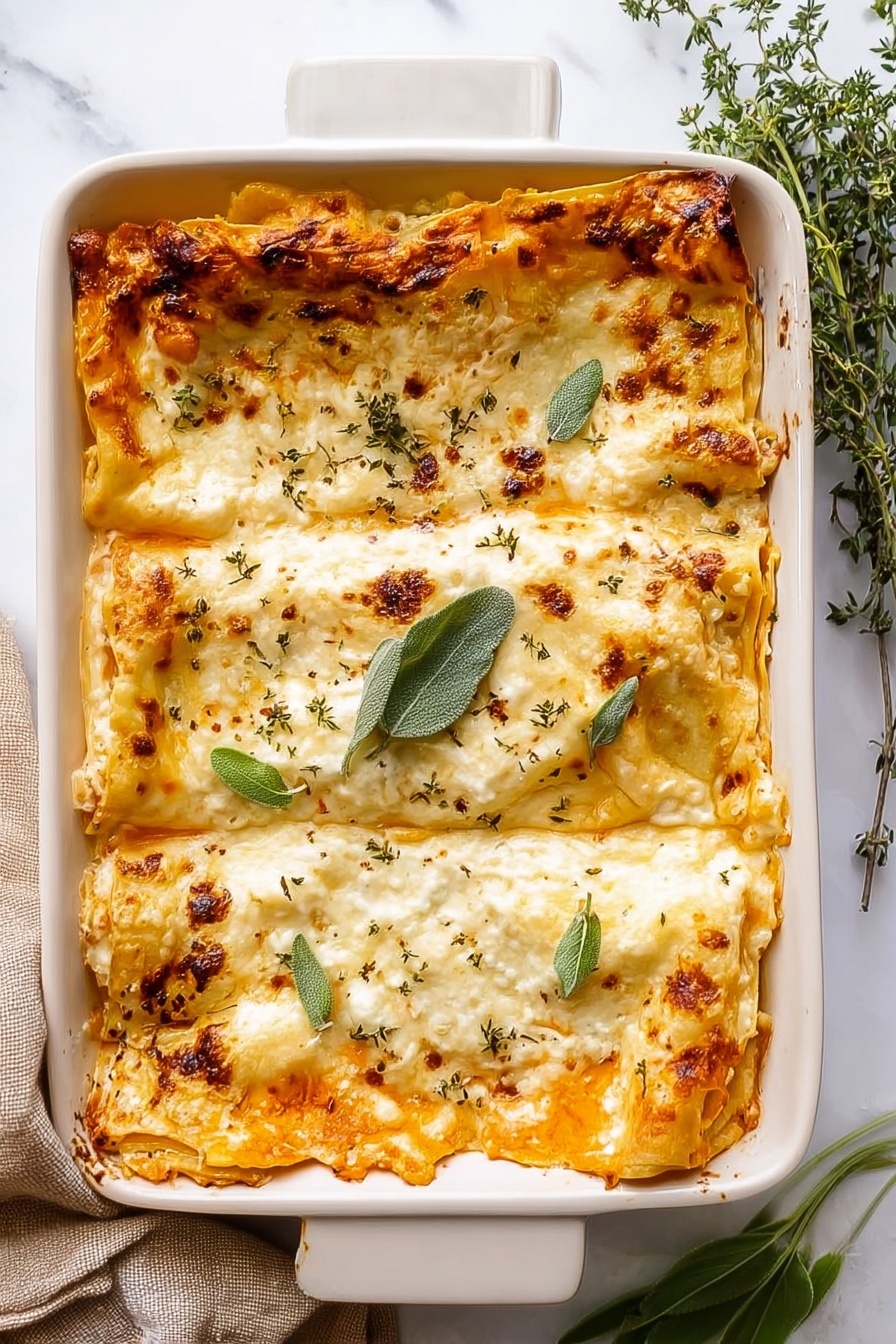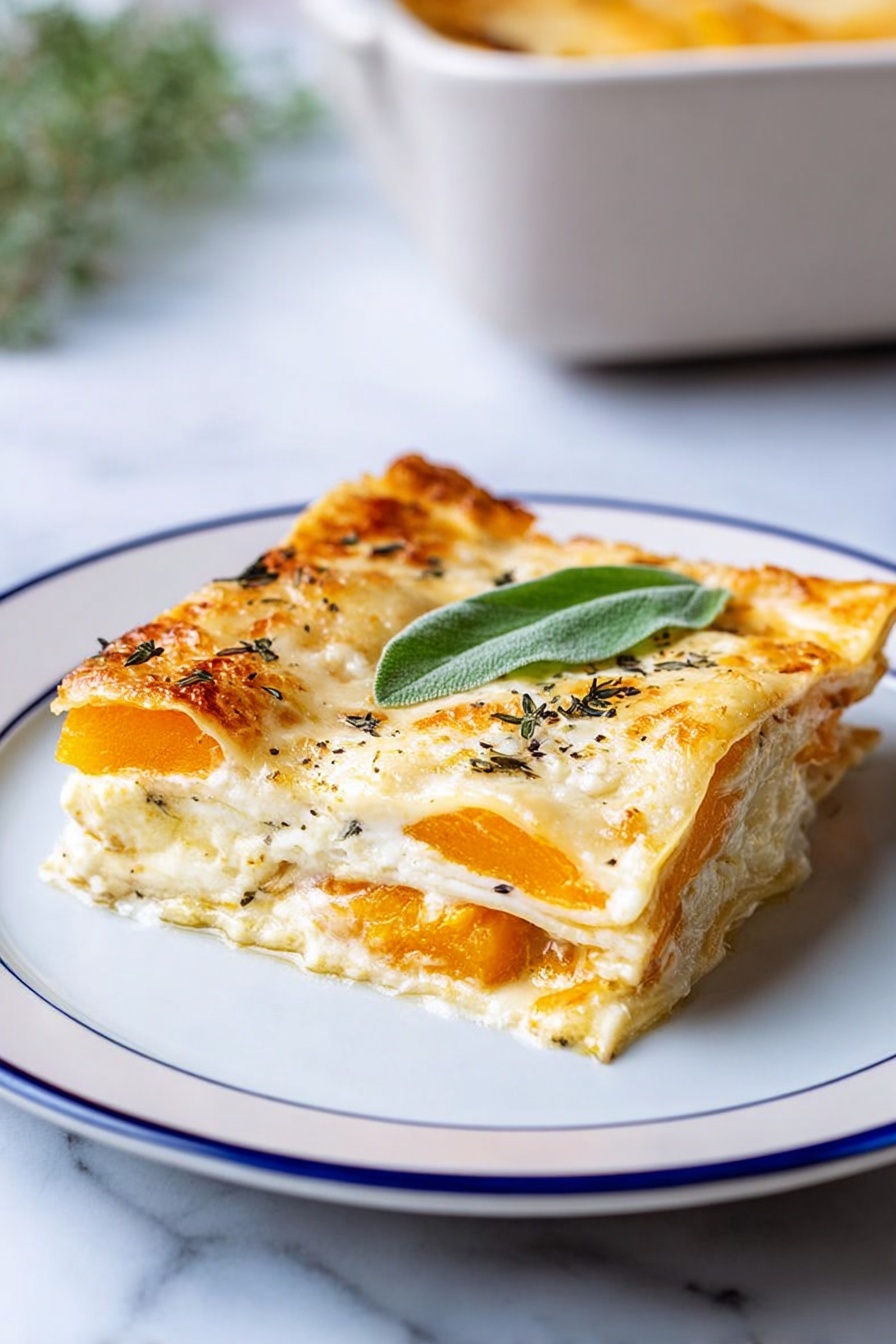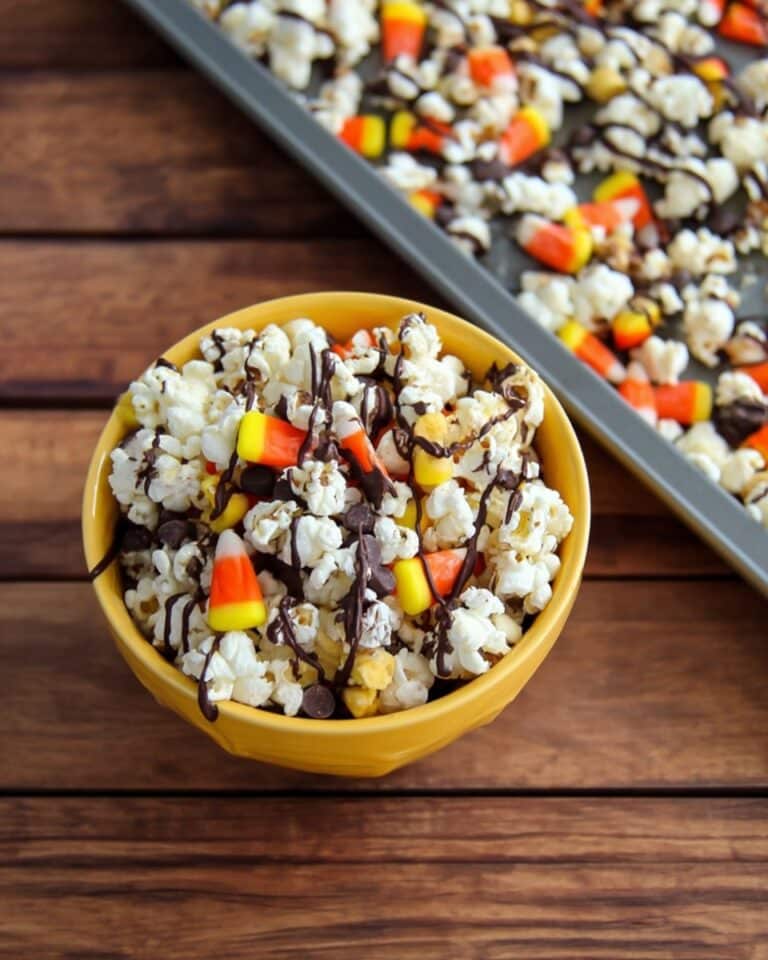If you’re on the hunt for a cozy, comforting dinner that still feels a bit special, I’m excited to share my Butternut Squash and Sage Lasagna Recipe with you. This isn’t your everyday red sauce lasagna—it’s layered with tender roasted squash, fragrant sage, and a luscious ricotta cheese sauce that’s honestly divine. When I first tried this combo, I was amazed at how the subtle sweetness of the squash and the earthiness of sage made such a dynamic pair. Trust me, once you make it, you’re going to want this recipe on regular rotation.
Why You’ll Love This Recipe
- Seasonal Flavor Boost: Butternut squash brings natural sweetness and creaminess that pairs beautifully with the herbaceous touch of fresh sage.
- Cheesy Comfort: The ricotta and mozzarella combo creates a rich, gooey texture without being overly heavy.
- Flexible and Friendly: Whether you’re cooking gluten-free or just looking for a vegetarian option, this recipe easily adapts.
- Make-Ahead Magic: Prepare parts or the entire lasagna in advance for a stress-free dinner later in the week.
Ingredients You’ll Need
The ingredients here come together so harmoniously. I always recommend choosing fresh sage and good-quality ricotta—it really makes a difference. Also, if you can find a nice firm butternut squash, that’ll save you time peeling and ensure perfect texture.

- Butternut Squash: Choose a medium-sized squash that’s firm and free of soft spots; a serrated peeler or sharp knife helps with peeling.
- Olive Oil: Use extra virgin for the best flavor in roasting the squash and coating the noodles.
- Kosher Salt: Enhances all the flavors without overwhelming them.
- Garlic Powder: Adds a gentle bash of savoriness without overpowering the delicate squash.
- Lasagna Noodles: Opt for gluten-free if needed, or fresh noodles if you prefer to skip boiling.
- Fresh Sage: Bright and earthy, chopping it fresh adds a lovely herbaceous kick.
- Lemon Zest: This little citrus burst keeps the dish lively and balanced.
- Ground Nutmeg: Just a pinch complements the squash and sage beautifully.
- Milk: Whole milk works best for creamy ricotta sauce but low-fat is fine too.
- Ricotta Cheese: Pick a good quality whole milk ricotta that’s creamy and smooth—trust me, it’s worth it.
- Fresh Ground Black Pepper: To season and brighten the dish.
- Pecorino Cheese: Adds a sharper, salty bite and depth to the cheesy layers.
- Mozzarella Cheese: Use part-skim or whole milk shredded mozzarella for that gooey melt.
Variations
I love how versatile this Butternut Squash and Sage Lasagna Recipe is—you can tweak it easily to fit your taste or dietary needs. I’ve experimented with a few variations depending on the season and who’s coming over.
- Adding Crispy Pancetta or Bacon: When I want to add a smoky punch, a little pancetta crisped and folded into the layers takes this from vegetarian to wow-worthy meat-lover’s delight.
- Swap in Spinach or Kale: I sometimes add sautéed greens for an extra veggie boost; they complement the squash and keep it hearty.
- Go Vegan: Use dairy-free ricotta and mozzarella alternatives, and swap milk for almond or oat milk—the flavors adapt nicely.
- Make it Gluten-Free: I use gluten-free lasagna noodles when friends can’t eat gluten, and it’s just as delicious.
How to Make Butternut Squash and Sage Lasagna Recipe
Step 1: Prepare the Butternut Squash
Start by peeling and cubing your butternut squash into roughly half-inch pieces. If you haven’t tackled a butternut squash before, I highly recommend watching a quick video on how to do it safely—it saved me so much time and frustration! Then, boil the cubes in salted water for about 5 to 6 minutes until they’re fork tender but not mushy. Drain them well and then toss with olive oil, kosher salt, and a pinch of garlic powder. This simple seasoning brings out the natural sweetness while adding a subtle depth.
Step 2: Cook the Lasagna Noodles
While your squash is boiling, bring a large pot of salty water to a boil and cook your lasagna noodles until just shy of al dente—around 5 minutes. You want the noodles flexible but with a little bite since they’ll finish cooking in the oven. Drain them and spread them out on an olive oil-drizzled baking sheet to keep them from sticking. Flipping them in the oil really helps when layering to avoid tears—a little trick I picked up early on saves so much hassle!
Step 3: Make the Ricotta Cheese Sauce
In a bowl, combine the ricotta cheese with lemon zest, a pinch of nutmeg, salt, pepper, and most of the chopped fresh sage (saving a bit for garnish). Slowly stir in the milk until you get a creamy, spreadable consistency. This sauce is the heart of the lasagna—it adds just enough tang and richness to balance the sweetness of the squash.
Step 4: Assemble Your Butternut Squash and Sage Lasagna
Grab a 9 x 13” baking dish and spread a thin layer of ricotta sauce on the bottom to keep things from sticking. Lay down your first layer of noodles, followed by half the cooked butternut squash, about two-thirds of the cheese sauce, a cup of mozzarella, and roughly a third of the Pecorino cheese. Repeat with another noodle layer and the remaining squash and cheeses. Finally, top with a last noodle layer, spread the rest of the ricotta sauce evenly on top, and finish with mozzarella, Pecorino, and that last sprinkle of fresh sage. The sage aroma going into the oven is one of my favorite parts—it smells like fall in your kitchen.
Step 5: Bake and Enjoy
Cover the lasagna tightly with foil and bake at 375°F for 40 minutes. Then remove the foil and bake for another 20 minutes or until the top is beautifully browned and bubbly. Let it rest for around 5 to 10 minutes before serving—this step helps it settle so you get perfect slices every time. My family goes crazy for this part because leftovers taste even better the next day!
Pro Tips for Making Butternut Squash and Sage Lasagna Recipe
- Perfect Squash Texture: Don’t overboil the squash – it should be tender but not falling apart; this gives your lasagna nice layers instead of a mushy one.
- Noodle Handling: Drizzle your noodles lightly with olive oil as soon as they’re cooked to keep them from sticking while assembling.
- Fresh Sage Matters: Using fresh sage instead of dried elevates the flavor enormously; chop it just before mixing for maximum aroma.
- Resting Time: Letting the lasagna rest after baking makes cutting easier and flavors meld together, so don’t skip it!
How to Serve Butternut Squash and Sage Lasagna Recipe

Garnishes
I like to add a few fresh sage leaves lightly crisped in a pan for garnish—adds a delightful crunch and booms with sage aroma. A sprinkle of extra Pecorino right before serving also gives a nice salty pop. If you’re feeling fancy, a drizzle of good-quality olive oil rounds everything out perfectly.
Side Dishes
This lasagna pairs beautifully with a simple green salad tossed in lemon vinaigrette or roasted Brussels sprouts for a touch of bitterness to balance the sweet layers. For a cozy dinner, I often serve it with garlic bread rubbed with fresh herbs—it’s always a hit with guests.
Creative Ways to Present
For special occasions, I’ve layered this Butternut Squash and Sage Lasagna Recipe in individual ramekins for an elegant, personal touch. It’s also lovely served in a deep-dish skillet at a casual get-together, letting everyone help themselves family-style. Presentation with garnished fresh herbs and perhaps a sprinkle of toasted pine nuts makes it look as good as it tastes.
Make Ahead and Storage
Storing Leftovers
After baking, cool the lasagna to room temperature and store leftovers covered tightly in the fridge. I usually keep leftovers in the baking dish wrapped with foil or transfer to airtight containers. It keeps beautifully for up to 2 to 3 days. The flavors actually deepen, so leftovers are fantastic the next day.
Freezing
Freezing this lasagna works really well if you cut it into individual portions first—store each slice wrapped tightly in plastic wrap and foil or an airtight container. When I’ve done this, I just defrost in the refrigerator overnight before reheating, and it holds up without losing sauce or texture.
Reheating
To reheat leftovers, place the lasagna in an oven-safe dish covered with foil and bake at 400°F for about 15 to 20 minutes or until warmed through. This method keeps the top from drying out. I avoid microwaving because it can make the noodles rubbery, but if you are in a pinch, reheat gently in short bursts.
FAQs
-
Can I make this Butternut Squash and Sage Lasagna Recipe gluten-free?
Absolutely! Simply swap regular lasagna noodles for gluten-free noodles and follow the same cooking method. Ensure your ricotta and cheese are also gluten-free (most are, but double-check packaging), and you’re good to go.
-
Can I prepare this lasagna ahead of time?
Yes! You can boil your squash and noodles a day in advance, or assemble the entire lasagna and refrigerate it overnight. Just add an extra 10-15 minutes to your baking time if it’s coming straight from the fridge.
-
What if I don’t have fresh sage?
Fresh sage really makes the flavor here, but if you have dried sage, use about a third of the amount and add it during cooking rather than raw. The flavor will be less vibrant but still tasty.
-
Can I use fresh lasagna noodles instead of dried?
Definitely! Fresh noodles don’t require boiling beforehand; just layer them directly in the dish. This can save you some prep time and gives a lovely tender texture.
Final Thoughts
This Butternut Squash and Sage Lasagna Recipe holds a special spot in my kitchen rotation because it brings such cozy flavors with a fresh twist. It’s my go-to when I want comfort food that feels seasonal and a little fancy without any fuss. Give it a try—you’ll find it’s a crowd-pleaser whether it’s a quiet weeknight or a holiday gathering. I can’t wait to hear how your family and friends fall in love with it, just like mine did.
Print
Butternut Squash and Sage Lasagna Recipe
- Prep Time: 30 minutes
- Cook Time: 1 hour
- Total Time: 1 hour 30 minutes
- Yield: 9 servings
- Category: Main Dish
- Method: Baking
- Cuisine: Italian
- Diet: Vegetarian
Description
This Butternut Squash Lasagna with Sage is a comforting, flavorful twist on traditional lasagna, featuring tender roasted butternut squash, fragrant fresh sage, creamy ricotta cheese sauce with lemon zest and nutmeg, and a luscious blend of mozzarella and Pecorino cheeses. Perfect as a hearty vegetarian main dish, it combines roasted and boiled techniques, resulting in a rich, aromatic, and satisfying meal for family or guests.
Ingredients
For the Butternut Squash
- 2-pound butternut squash (medium), peeled and cut into 1/2-inch cubes
- ½ tablespoon olive oil
- ½ teaspoon kosher salt
- ¼ teaspoon garlic powder
For the Lasagna
- 9 to 12 lasagna noodles (6 to 8 ounces, gluten-free if necessary)
- 1 ½ tablespoons chopped fresh sage, divided, plus additional leaves as desired
- Zest of ½ lemon (about 2 teaspoons)
- ⅛ teaspoon ground nutmeg
- ½ cup plus 2 tablespoons milk
- 16 ounces (2 cups) whole milk ricotta cheese
- ¼ teaspoon kosher salt
- Fresh ground black pepper, to taste
- 1 cup shredded Pecorino cheese, divided
- 8 ounces (2 ½ cups) shredded mozzarella cheese, divided
Instructions
- Preheat the oven. Set your oven to 375 degrees Fahrenheit to prepare for baking the lasagna later.
- Boil the butternut squash. Peel and cube the butternut squash into ½-inch pieces. Bring a medium pot of water to a boil, add the squash cubes, and cook for 5 to 6 minutes until fork tender. Drain and transfer to a bowl, then toss with olive oil, kosher salt, and garlic powder to season.
- Cook the noodles. In a large pot of well-salted boiling water, cook the lasagna noodles for about 5 minutes, just before reaching al dente. Drain the noodles and place them onto an olive oil–draped baking sheet, turning each to coat and prevent sticking. If using fresh noodles, this step can be skipped.
- Prepare the ricotta sauce. In a medium bowl, combine 1 tablespoon of chopped fresh sage, lemon zest, nutmeg, ricotta cheese, salt, pepper, and milk. Stir thoroughly to create a smooth, flavorful cheese sauce. Reserve about ½ tablespoon of sage for garnishing the final lasagna.
- Layer the lasagna. In a 9”x13” baking dish, spread ½ cup of the ricotta sauce evenly on the bottom. Layer with noodles, half the cooked squash, approximately ⅔ cup ricotta sauce, 1 cup shredded mozzarella, and ⅓ cup Pecorino cheese. Repeat this layering with noodles, remaining squash, ⅔ cup ricotta sauce, 1 cup mozzarella, and ⅓ cup Pecorino. Top with a final noodle layer, spread the remaining ricotta sauce on top, then sprinkle with the remaining ½ cup mozzarella, ⅓ cup Pecorino, and the reserved sage leaves.
- Bake the lasagna. Cover the dish with aluminum foil and bake in the preheated oven for 40 minutes. Remove the foil and continue baking for another 20 minutes until the top is golden brown and bubbly. Let the lasagna rest for 5 to 10 minutes before serving. Leftovers can be refrigerated for 2 to 3 days and reheated at 400°F.
Notes
- If using fresh lasagna noodles, boiling is unnecessary.
- Make ahead ideas: Boil the butternut squash and noodles in advance and refrigerate, ensuring noodles are coated with olive oil. Alternatively, assemble the entire lasagna before baking and refrigerate overnight; increase bake time as needed.
- Storage: Refrigerate leftovers up to 2 days or freeze in single-serving portions. To reheat, thaw in the refrigerator and warm covered with foil at 400°F for about 15 minutes.
Nutrition
- Serving Size: 1 slice (approx. 1/9th of the pan)
- Calories: 350 kcal
- Sugar: 5 g
- Sodium: 480 mg
- Fat: 18 g
- Saturated Fat: 9 g
- Unsaturated Fat: 7 g
- Trans Fat: 0 g
- Carbohydrates: 32 g
- Fiber: 4 g
- Protein: 15 g
- Cholesterol: 45 mg









